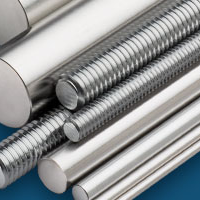HCT Molybdenum ROD
Elmet is a leading global provider of high-quality potassium doped (HCT) molybdenum rod and wire products and the only US owned and operated producer. HCT molybdenum rod is used where retention of low-temperature ductility after exposure to high temperatures is required. HCT is particularly applicable to resistance heating elements, lamp filament supports, sintering trays, and electronic tube components. Recrystallized HCT molybdenum develops interlocked, elongated grain structures that remain relatively ductile at room temperature and below.
Pure molybdenum is invariably embrittled after use at high temperatures. This can result in unanticipated failures, especially where vibration or mechanical handling occurs. The loss of ductility is a direct result of the development of equiaxed grain structures resulting from the recrystallization process. In contrast, recrystallized HCT moly develops interlocked, elongated grain structures that remain relatively ductile at room temperature and below.
This structure is achieved through small, controlled alloy additions and thermomechanical processing. The content of the residual alloy remains less than 200ppm. Ductility characteristics are dependent of the material form and physical dimensional parameters. Typically, thinner cross sections exhibit optimum properties. For manufacuring purposes, the density, heat capacity, thermal expansion and modulus of HCT are the same as pure molybdenum. The cold electrical resistivity is about 5% higher than the unalloyed material.
Range of Material
Elmet produces pure, potassium doped (HCT type), and lanthanated doped molybdenum rod. The potassium doped and the lanthanated doped products are targeted for use in higher temperature applications where ductility is retained after recrystallization for material with smaller cross-sections.
Availability
Molybdenum HCT rod is manufactured as random length pieces and Elmet will cut it to your desired lengths in diameters ranging from .020 inches to 1.75 inches. Standard diameter and length tolerances are listed in the accompanying tables. Other, closer tolerances can be quoted on request. Molybdenum rod is available in three different surface processes or finishes.
Surface Finish
- Black – The surface is “as swaged” or “as drawn,” retaining a coating of processing lubricants and oxides.
- Cleaned – The surface is chemically cleaned to remove all lubricants and oxides.
- Ground – The surface is centerless ground to remove all coating and to achieve precise diameter control.
Potassium Doped HCT Molybdenum Rod Products:
| Standard Diameter Tolerances (inches) | |||
| Diameter | Black/Clean | Ground | |
| .020 to .025 | ± .001 | ± .001 | |
| .025 to .070 | ± .0015 | ± .001 | |
| .070 to .200 | ± .002 | ± .001 | |
| .200 to .250 | ± .007 | ± .001 | |
| .250 to .435 | ± .007 | ± .0015 | |
| .425 to .750 | ± .010 | ± .003 | |
| .750 to 1.000 | ± .015 | ± .005 | |
| 1.000 to 1.250 | ± .015 | ± .005 | |
| 1.250 to 1.750 | ± .025 | ± .005 | |
| Tighter tolerances can be obtained upon request. | |||
| Standard Length Tolerances (Inches) | |||
| Diameter | .5″ to 12″ | 12″ to 24″ | > 24″ |
| .020 to .100 | ± .010 | ± .015 | ± .0625 |
| .100 – .500 | ± .015 | ± .015 | ± .0625 |
| .500 to 1.000 | ± .015 | ± .030 | ± .0625 |
| 1.000 to 1.500 | ± .030 | ± .0625 | ± .0625 |
| Tighter tolerances can be obtained upon request. | |||
Resources:
HCT Molybdenum Products Data Sheet 2023
Lanthanated Molybdenum Plate 2017
Molybdenum Physical-Mechanical Properties 2017
Molybdenum Chemical Interactions 2017
Molybdenum Rod, Wire, Plate, Sheet Product Data Sheet 2017
ABOUT OUR PROCESS:
Companies throughout the world depend on Elmet Technologies’ expertise in powder metallurgy. Our advanced powder processing produces pure tungsten and molybdenum metal powders and specific metal alloys. At Elmet, our process is fully integrated. We start with the raw material which is purified to tungsten and molybdenum metal powder through a chemical reduction process. The powder is then formed into semi-finished products through a series of advanced mixing, pressing, deformation and heating technologies. The finished products are carefully manufactured to customer specifications utilizing our state-of-the-art machining and fabrication techniques. By selectively influencing aspects of the metallurgical process, we can change characteristics like porosity, strength, and temperature resistance.

